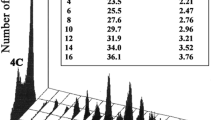Abstract
Human and Chinese hamster chromosomes were obtained from cells grown in the presence of 5-bromodeoxyuridine (BrdU) for (a) one replicative round, (b) two replicative rounds, (c) one replicative round followed by another round in thymidine and (d) the last period of synthetic phase. Untreated chromosomes and chromosomes treated with UV radiation after previous staining with 33258 Hoechst as photosensitizer were studied in order to investigate the mechanism(s) responsible for BrdU-induced sister chromatid differentiation (SCD). Metaphases were prepared by (1) standard methanol—acetic acid fixative for subsequent investigation with Giemsa or DNA-specific dyes such as ethidium bromide, acridine orange and monoclonal antibodies to double-or single-stranded DNA; (2) the procedure for observation under phase-contrast or electron microscopy; and (3) the cytospin method for subsequent immunoreaction with a monoclonal antibody to histone H2B. Our data exclude the possibility that the presence/absence of BrdU in the template strand might affect chromatin organization and thus resistance, while confirming that UV-induced DNA alteration is not sufficient, by itself, to explain SCD mechanism(s). That molecules other than DNA play a role in explaining SCD production is indicated by the fact that BrdU incorporation induces alterations in DNA—histone H2B interactions which, in turn, seem to produce structural variations in chromatin, possibly at the level of condensation, as monitored by phase-contrast and electron microscopy.
Similar content being viewed by others
References
Bobrow M (1973) Acridine orange and the investigation of chromosome banding.Cold Spring Harb Symp Quant Biol 38: 435–440.
Borsa J, Whitmore GF (1969) Studies relating to the mode of action of methotrexate. I. Studies on sites of action in L-cellsin vitro.Mol Pharmacol 5: 303–317.
Burkholder GD (1982) The mechanism responsible for reciprocal BrdU-Giemsa staining.Exp Cell Res 41: 127–137.
Buys CHCM, Osinga J, Stienstra S (1981) Rapid irradiation procedure for obtaining permanent differential staining of sister chromatids and aspects of underlying mechanism.Hum Genet 57: 35–38.
Camargo M, Cervenka J (1982) Patterns of DNA replication of human chromosomes. II. Replication map and replication model.Am J Hum Genet 34: 757–780.
David J, Gordon JS, Rutter WJ (1974) Increased thermal stability of chromatin containing 5-bromodeoxyuridine-substituted DNA.Proc Natl Acad Sci USA 71, 2808–2812.
Gantt R, Jones GM, Stephens EV, Baeck AE, Sanford KK (1979) Visible light-induced DNA crosslinks in cultured mouse and human cells.Biochem Biophys Acta 565: 231–240.
Gonzales-Gil G, Navarrete MH (1982) On the mechanism of differential Giemsa staining of BrdU-substituted chromatids.Chromosoma 86: 375–382.
Gordon JS, Bell G, Martison HG, Rutter WJ (1976) The selective interaction of 5-bromodeoxyuridine (BrdU) substituted deoxyribonucleic acid with different chromosomal proteins.Biochemistry 15: 4778–4786.
Goto K, Akematsu T, Shimazu H, Sugiyama T (1975) Simple differential Giemsa staining of sister chromatids after treatment with photosensitive dyes and exposure to light and the mechanism of staining.Chromosoma 53: 223–230.
Goto K, Maeda S, Kano Y, Sugiyama T (1978) Factors involved in differential Giemsa-staining of sister chromatids.Chromosoma 66: 351–359.
Hutchinson F (1973) The lesions produced by ultraviolet light in DNA containing 5-bromouracil.Q Rev Biophys 6: 201–246.
Ikushima T, Wolff S (1974) Sister chromatid exchanges induced by light flashes to 5-bromodeoxyuridine and 5-iododeoxyuridine-substituted Chinese hamster chromosomes.Exp Cell Res 87: 15–19.
Jack EM, Harrison CJ, White GRM, Ockey CH, Allen TD (1989) Fine structural aspects of bromodeoxyuridine incorporation in sister chromatid differentiation and replication banding.J Cell Sci 94: 287–297.
Jan KY, Tzeng Y-T, Lee T-C (1985) Opposite staining effect of two silver staining techniques on sister chromatids.Exp Cell Res 159: 55–62.
Kasten FH (1973) Acridine dyes. In: Gray P, ed.The Encyclopedia of Microscopy and Microtechnique New York: Van Nostrand Reinhold, pp 4–7.
Korenberg JR, Freedlander EF (1974) Giemsa technique for the detection of sister chromatid exchanges.Chromosoma 48: 355–360.
Latt SA (1973) Microfluorometric detection of deoxyribonucleic acid replication in human metaphase chromosomes.Proc Natl Acad Sci USA 70 3395–3399.
Mezzanotte R, Peretti D, Orrù Set al. (1989) DNA alteration induced by ultraviolet light in human metaphase chromosomes substituted with 5-bromodeoxyuridine: monitoring by monoclonal antibodies to double stranded and single stranded DNA.Chromosoma 97: 356–362.
Ockey CH (1980) Autoradiographic evidence of differential loss of BrdU-substituted DNA after UV exposure in FPG harlequin staining.Exp Cell Res 125: 511–514.
Pathak S, Stock D, Lusby A (1975) A combination of sister chromatid differential staining and Giemsa banding.Experientia 31: 916–917.
Pauluhn J, Naujok A, Zimmermann HW (1980) Uber die quantitative fluorometrische Bestimmung von DNA mit Ethidiumbromid in der Zelle und die Konstanz der Quantenausbeute des Ethidium-DNA-Komplexes im biologischen Milieu.Z Naturforsch 35c: 585–598.
Perry P, Wolff S (1974) New Giemsa method for the differential staining of sister chromatids.Nature 251: 156–158.
Ris H (1978) Preparation of chromatin and chromosomes for electron microscopy.Methods Cell Biol 18: 229–246.
Schiaffonati L, Tsutsui Y, Chang SD, Baserga R (1978) Effect of 5-bromodeoxyuridine on deoxyribonucleic acid—protein adducts induced by ultraviolet light on chromatin and cells.Lab Invest 38: 58–66.
Speit G (1984) Considerations on the mechanism of differential Giemsa staining of BrdU-substituted chromosomes.Hum Genet 67: 264–269.
Sumner AT (1982) The nature and mechanism of chromosome banding.Cancer Genet Cytogenet 6: 59–87.
Takayama S, Taniguchi T (1986) Light and scanning electron microscopic observations on the two contrasting types of sister chromatid differential staining after ultraviolet light irradiation.Chromosoma 93: 404–408.
Turner BM (1982) Immunofluorescent staining of human metaphase chromosomes with monoclonal antibody to histone H2B.Chromosoma 87: 345–357.
Turner BM, Keohane A (1987) Antibody labelling and flow cytometry analysis of metaphase chromosomes reveals two discrete structural forms.Chromosoma 95: 263–270.
Webber LM, Brasch JM, Smyth DR (1981) DNA extraction during Giemsa differentiation of chromatids singly and doubly substituted with BrdU.Chromosoma 81: 691–700.
Whitfield WGF, Fellows G, Turner BM (1986) Characterization of monoclonal antibodies to histone h2b. Localization of epitopes and analysis of binding to chromatin.Eur J Biochem 157: 513–521.
Yunis JJ, Jeffrey RS, Ball DW (1978) Characterization of highresolution G-banded chromosomes of man.Chromosoma 67: 293–309.
Author information
Authors and Affiliations
Rights and permissions
About this article
Cite this article
Ribas, M., Korenberg, J.R., Peretti, D. et al. Sister chromatid differentiation in 5-bromo-2′-deoxyuridine-substituted chromosomes: A study with DNA-specific ligands and monoclonal antibody to histone H2B. Chromosome Res 2, 428–438 (1994). https://doi.org/10.1007/BF01552865
Received:
Revised:
Accepted:
Issue Date:
DOI: https://doi.org/10.1007/BF01552865




